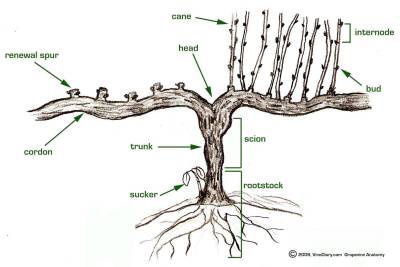Pruning grapevines
In their first years grape plants are “trained” by pruning. There are two methods of pruning: cane pruning and spur or cordon pruning.
This DVD Proper Methods for Pruning Grapevines, is a demonstration of the two methods of pruning grapevines: training to spurs and training to canes.
This is a good online introduction to training grape plants at The Spruce, which offers practical tips.
Cane pruning verses cordon pruning. (To understand the following terminology, see page 2 of OSU’s Growing Table Grapes, “how grape plants grow”. Some of the following information about cane pruning was extracted from Growing Backyard Grapes in the Puget Sound Region by John Taylor, based on his work with the Western Washington Fruit Research Foundation.
Here is a comprehensive explanation of the value of pruning - While Grapevines Sleep at The Jordan Winery.
Prune to canes
The backyard grower, with few plants to tend, can choose cane pruning, as he is not dependent on unskilled labor for pruning. To create fruiting shoots, each year the cane pruner selects a cane growing from each side of the head of the plant and cuts off all other canes. On mature plants the selected cane is cut at the distance from the head so as to meet the cane from the adjacent plant. Younger or weaker plants can have canes pruned back to where they are pencil size. These are judgment calls. With cordon pruning permanent “arms”, or cordons, are trained along the wire.
The right part of the illustration below illustrates cane pruning.
Advantages of cane pruning
First, there are buds on the cane that are not close to the head. In cordon pruning the shoots originate from a few buds close to the cordon. These buds, formed early in a sunless growing season, may not have had the warmth needed to develop fruitful buds. Also American grape plants may not have fruitful buds close to the cordon.
Second, the cordon may not have the proper spacing of buds for optimum distance between shoots. This condition persists until the cordon is replaced.
Third, there is the tendency for a strong shoot to grow at the end of the cordon, called apical dominance; this growth is not much good for anything. With cane pruning, dominance is transferred from the tip (or apex) by arching the cane over a wire perhaps 12 to 18 inches higher than the wire at the head of the plant allowing the middle part to be higher than the tip. This causes shoot growth to be more evenly distributed along the cane.
When the shoots are long enough to reach a wire another 18 inches above the arching wire move the shoots behind the wire to create a narrow vertical wall of foliage with the shoots weaving upwards back and forth through the wires of the trellis. A leaf without full exposure to the sun is 90 percent less efficient than one fully exposed. A wire 6 feet above the ground, at the top of the trellis, will be the next training wire (a total of 4 wires). Growth above this wire can be removed. A rule of thumb is that each shoot should support about 14 leaves.
 This illustration from vinodiary.com visualizes the parts of a grapevine.
This illustration from vinodiary.com visualizes the parts of a grapevine.
Prune to spurs
The left part of the illustration illustrates cordon or spur pruning.
